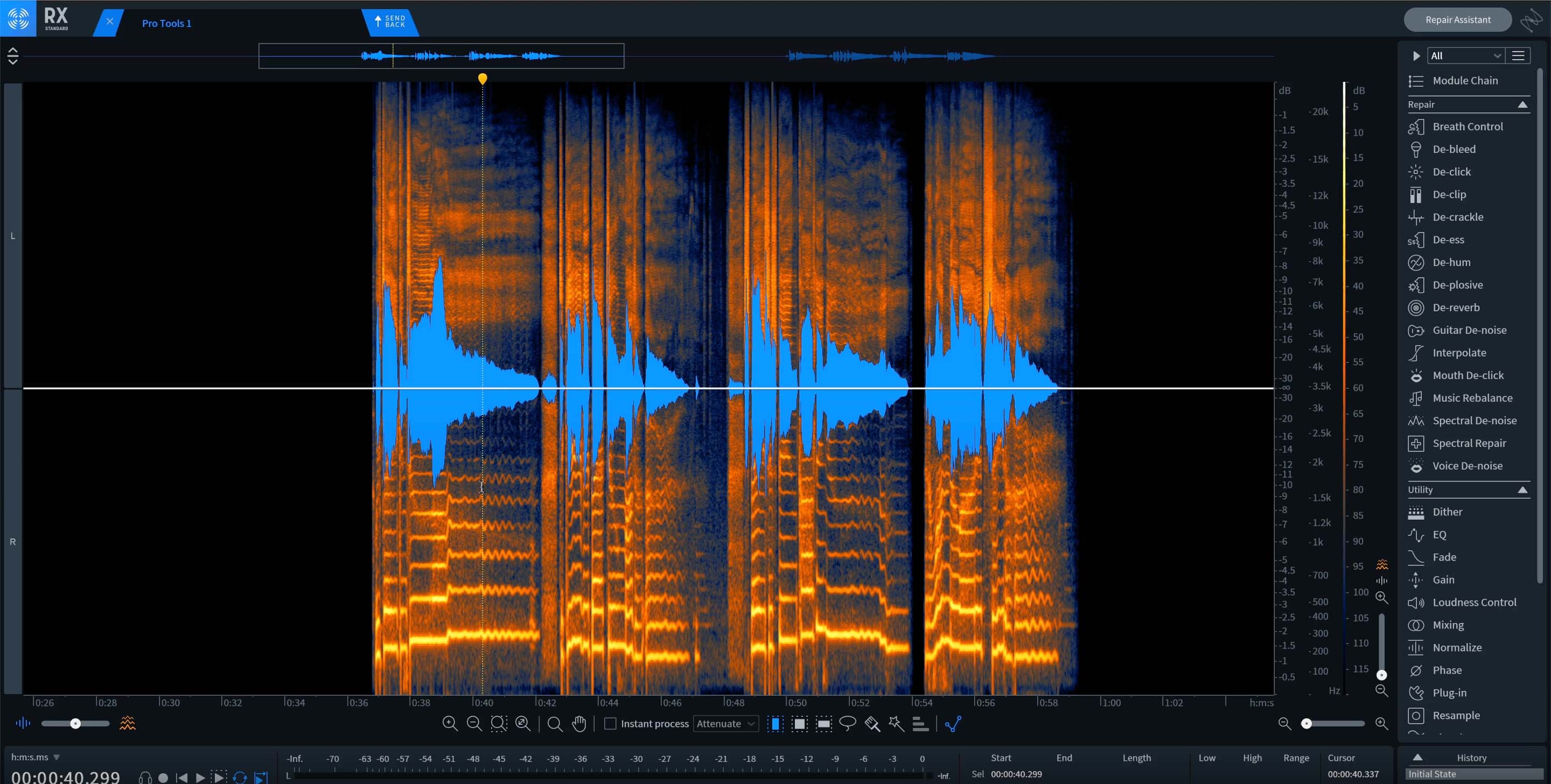
How to clean up audio and remove background noise
In this guide, discover different types of audio problems and how to take care of them using iZotope RX, a powerful background noise removal and audio enhancement plugin.
Basics of Audio Cleanup & Background Noise Removal
Learn the basics of audio cleanup with answers to some of the most frequently-asked questions.
Discover new audio cleanup features
Learn about groundbreaking tools for audio cleanup and background noise removal with the new iZotope


RX 11 Advanced
Top questions about audio cleanup and background noise removal
What are some common types of unwanted background noise in audio recordings?
Common background noises include hum, clicks, clipping, and general ambient noise such as fans, traffic, or room echo.
How can I remove background noise from audio using iZotope RX?
You can use the Voice De-noise module in iZotope RX, which allows you to reduce noise in real time or by learning the noise profile.
What is the best way to remove clipping from an audio file?
Use the De-clip module in iZotope RX to repair distorted audio caused by clipping.
How do I reduce reverb or echo in a recording?
The De-reverb module in RX can help reduce room echo and reverberation, improving clarity.
Can I automate the audio cleanup process?
Yes, iZotope RX features tools like Repair Assistant that use AI to automatically suggest and apply fixes.
When do I need to use audio cleanup and noise reduction software?
In today’s world, audio and video recordings can be made by almost anyone. From smartphones to sophisticated studios and sound stages, large amounts of media content are created daily. And as our world becomes increasingly and audibly congested, the rate of ruined recordings is rising in tandem. Human error, unexpected electrical or mechanical interference, and unwelcome intrusions from aircraft, cell phones, pets, people, and Mother Nature regularly impact even the most seasoned professional. Many times, it just isn’t possible to record that “perfect take” over again, particularly when editing coverage of a live event, or working to meet budgets and deadlines.
Whether you’re a professional or just getting started, you’ve probably run into difficult audio situations like those mentioned above, and wished you could correct what seemed like an impossible dilemma. Using a tool like iZotope RX can help you repair any audio issues or reduce background noise to get better quality audio.
How do I clean up audio?
Cleaning up your audio with iZotope RX combines familiar visual selection tools that are found in plug-ins and digital audio workstations (DAWs) with a visual spectrogram display and advanced audio processing, enabling you to perform powerful audio edits.
The goal of good audio repair and restoration is to render the best possible sonic result with the least audible human intrusion. In essence, your intervention in the original recording should be transparent and not introduce new artifacts that distract the listener.
Sometimes it’s possible to solve an audio problem entirely, and other times it’s about finding the right balance between reducing the problem and preserving the original audio. It’s useful to remember that no recording is truly perfect, and any statement as such is purely subjective.
Cleaning up your audio can yield the following results:
- Reduce both ambient and signal-based background noises such as hiss, hum, and buzz—without sacrificing the fidelity and clarity of the original audio.
- Isolate and then reduce or accentuate specific audio events, such as sudden background noises.
- Replace damaged or missing sections of an audio file with seamless, natural sounding patches.
- Eliminate pops, clicks, and mouth noises without audible artifacts.
- Repair audible analog and digital clipping with perfect precision.
Is there a way to remove background noise from audio?
Yes, there are ways to reduce and even remove background noise from audio. Background noise in recordings, if left untreated, is likely to create problems down the road when EQ and compression are applied. Frequency boosts or cuts and dynamic range adjustments can make the noise more noticeable.
There are two types of background noise: steady (also called ambient noise) and sudden background noise. Steady background noise means noise that is not changing, like hiss, hum, and buzz. Removing steady background noise can improve the overall listening experience, increase intelligibility in dialogue tracks, remove interferences like electrical hum from a musical performance, and make it easier to combine different audio files into one scenario when mixing sound for picture.
Sudden background noise includes coughs, ringing cell phones, beeping, etc. Sudden noises can include a wide range of intrusive sounds that don’t fall into the steady or impulse categories. These can include a cell phone ringing at a violin recital, a door hinge squeaking during an interview, or traffic noise interrupting the dialogue being recorded for a film.
Most types of interference, especially those that happen on dialogue recordings, can be tackled with iZotope RX plug-ins including De-noise, De-hum, Dialogue Isolate, De-Bleed, Spectral Repair, and more.
What does background noise removal sound like?
Here are audio examples of audio cleanup and background noise removal using Dialogue Isolate in iZotope RX.
Dialogue with Background Noise
Take note of the differences you’re hearing in the before and after of this interview using RX Dialogue Isolate. Notice how the background noise disappears with minimal disruption to the interview itself?
Start cleaning up your audio with RX Get iZotope RX
How to Clean Up Audio
While there are many aspects of audio cleanup, these are basic steps and techniques used to achieve a professional sound.
Before you begin: learn the key elements of audio cleanup and background noise removal
Before you learn how to remove background noise and clean up audio from your recording, it’s important to get familiar with the tools used to process the audio.
All of your audio edits will be done by viewing a waveform or a spectrogram. A spectrogram is a detailed view of audio, able to represent time, frequency, and amplitude all on one graph. A spectrogram can visually reveal broadband, electrical, or intermittent noise in audio, and can allow you to easily isolate those audio problems by sight.

Vocals in the RX spectrogram